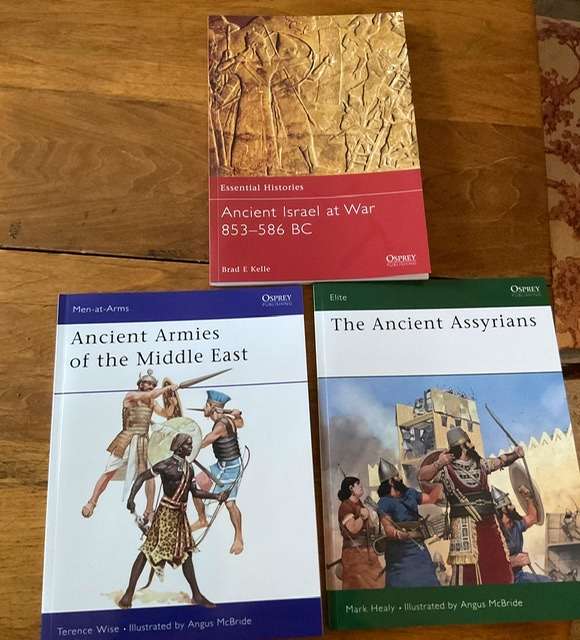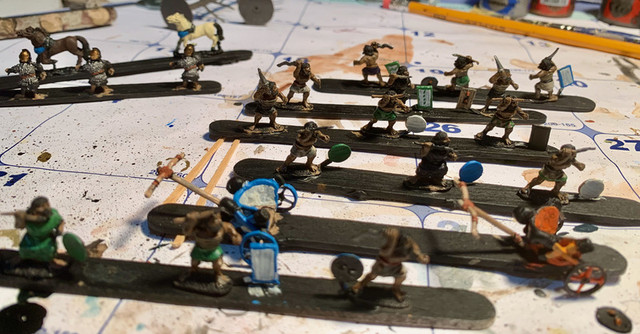Hello friends:
I’ve been in a bit of a blogging funk lately but I thought I should shake it off to report that I seem to have been bitten by the biblical bug. Normally I’m quite reluctant to pick up a new period or scale. In fact, I’ve recently purged my quite large 20mm WW2 collection to force myself to focus more on fewer projects. However, for some reason, I found myself ordering these three books.

(Annoyingly, the bottom two books disappeared without a trace. My wife said with a stricken face that she may have scooped them up in a stack of recycled magazines, so the Assyrian book is reordered from Osprey).
So why ancient biblical armies? Partly it’s because I’ve been listening a lot to the Mad Axeman podcasts. Tim Porter and his crew make ancients gaming sound like too much fun, and all a bit mad, really. I confess I’ve never been that sold on the idea of ancients gaming. Line up two mobs with stabby pointy things, sound a horn, they all run at one another and bish bosh one side or another runs away. I’m intrigued enough now to have a go myself.
Also, as a wargaming vicar, it really just seems like something I should do. Recently I taught a course on the Book of Isaiah, and had to restrain myself from telling my students too much about the military details, though they are in themselves fascinating. The 7th century BCE has loads of interest, perhaps starting with the Assyrians, the apex predator of the period, but there is of course the two kingdoms of Israel and Judah, Syria or Aram and its various city states, and Egypt to the south, so quite a few armies and possible matchups. Of course, the idea that all these armies have chariots makes it appealing (see 2 Kings 9.20).
So what rules to use? Again, to thank Tim and the Mad Axeman crew, the new edition of ADLG seems worth a look, and it’s many army lists will help me, a newcomer to the period, figure out the basic troop types and which army looks like what.

I reached out to Tim on Twitter and asked his advice on figure manufactures, of which there are many. To field largish armies and to make the painting faster, 15mm seemed the best scale. I settled on Fighting 15s / Gladiator Miniatures, ordering a bunch of fairly generic infantry and a variety of two horse chariots with a variety of armoured and unarmored crew. This should be enough to flesh out Syrian and Hebrew armies with some Bedouin allies. I’ll add the Assyrians on a subsequent purchase. Here are some test figures almost done.

It’s a back burner project for now but a pleasant change of pace.
Cheers and thanks for reading!
MP+

Welcome to the world of ADLG! It's a great ruleset for reasonably quick games with armies that are large enough to give tactical options whilst not giving you a hernia when carrying them.
ReplyDeleteI'll probably be adding some figures to my Sea Peoples army to convert them from Peleset to Philistines (mostly a switch from javelins to bows as the missile weapons of choice). At some point I will do an Assyrian army, but that might be a 2023 project - I have too many other projects to get done first.
Hi Tamsin, thanks for the welcome, you and your pod crew are largely to blame for this enthusiasm of mine!
DeletePhilistines would make for great opponents to my nascent Hebrew army, with echoes of Sunday school.
Cheers, Mike
A Biblical project sounds perfect, Michael! Now, snap out of the funk and get back to business of hammering our posts.
ReplyDeleteI am sure I have a spare copy of Ancient Armies of Middle East if you are needing one.
Yes sir! Snapped out of funk, sir!
DeleteIf you're speaking of the 1984 Stillman and Tallis WRG book, a used copy just arrived in the post from New Zealand! It looks invaluable.
Hi Michael -
ReplyDeleteIt's not an area I do, but one that has tempted me greatly in the past. I was very tempted to get a Hittite Empire army - but for a niggling doubt that the Hittite Empire really existed, at least in the form modern historiography suggests. But perhaps a 'Hittite Kingdoms' army circa Ahab and Jehoshaphat might have been the go - along with, say, Syrians and Israelites/ Judeans. Methinks one could have a quite a bit of fun with that period of Levantine history.
You know, I have long thought that Biblical historiography is not generally treated with sufficient respect. I suppose (I'm guessing) that as its perspective is largely theological or theocratical - not to mention subject to rewritings (copyings) - it is treated as suspect, though why more so than other sources, I don't really understand.
I'll tell you something that to my mind goes in favour of Biblical historiography to my mind, even though it presents a difficulty. For much of the First Book of Kings, whenever the kings of Israel and Judah are mentioned together, the latter is mentioned by name (Jehoshaphat usually) but not 'the King of Israel'. Usually this is supposed to be Ahab, and at other places in the Old Testament he is mentioned by name. There seems to have been some ambiguity as to whether Ahab was killed at Ramoth-Gilead or, having been badly wounded, lived a little longer. At any rate, it is small things like that that suggest to me that from an historiographical point of view, the Old Testament isn't telling fairy stories.
I'll certainly be on the lookout for future wars, campaigns and battles from the annals of the Levant!
Cheers,
Ion
Thanks Ion for a characteristically thoughtful response. I too have found the Hittites to be the one ancient kingdom that I've never understood or made concrete in my thought, perhaps because it is extra-biblical. I always get them mixed up with the Hurri and Mitanni. I do agree with you that the biblical accounts of this period have large kernels of history in them, in part because of their theological biases. The authors of First and Second Kings, like Isaiah, were often quite angry with the rulers if they deviated from Jewish orthodoxy, and often see Israel/Judah's enemies, like the Assyrians, as instruments of God's vengeance. In that respect, there is a "dissenting" quality to the biblical narratives, which perhaps makes them more truthful than, say, the Assyrian propagandistic narratives. So yes, not fairy stories.
DeleteI hope to have some battles for you in the fullness of time.
Cheers, Mike
Seems a very appropriate theme for you Padre, one that has tempted me many times.
ReplyDeleteHi Peter. Yes, it does seem appropriate, and I finally gave into temptation. Maybe you will, too!
DeleteEh no point worrying about posting mate. It’s here for when you want to and obviously you didn’t. No bother at all. Just glad you found a little energy and impetus to show off your new project!
ReplyDeleteCheers, Dai!
DeleteInteresting project Mike, l look forward to seeing it progress…
ReplyDeleteThanks Your Grace.
DeleteAlways good to purge some of our collections (heresy for some) to allow focus, but as in this case, it can lead to new projects. I've always struggled with Ancients, mainly I think due to the lack of 'good' historical fact upon which to base assumptions about how armies fought etc. Maybe I'm wrong but that's just me!
ReplyDeleteI agree, Steve, it's one of those periods where its easy to feel totally out of our depth because most of us I think don't have a good historical grounding for this period. What did they wear? What weapons did they use and how? What formations? How did chariots work? Most of us have a baseline for how, say, modern warfare works, but there's a lot of self-education required to learn a period this distant in time.
DeleteYes, purging is hard. I put my 20mm kit into three large boxes and shipping them to their new owners was a hard thing to do!
Cheers,
Mike
An ideal project for you Mike! I look forward to see more. Just don't leave the new books next to the magazines anymore.....just incase?
ReplyDeleteCheers, Ray. My wife is a compulsory tidier, so I'm learning to be careful and not leave my stuff lying around!
DeleteInteresting project, one I have at the back of my mind with my motley acquired Peter Laing Ancients armies, as some 40+ years old forgotten overdue Scripture and Sunday School scholarship or history learning. I look forward to reading your future posts.
ReplyDeleteThanks Mark, I hope to have something to deliver. I think a lot of us have dim recollections of Sunday school lessons and children's bible illustrations (David vs Goliath, Samson vs the Philistines) at the back of our minds when we think about this period!
DeleteI will follow this keenly. I'm toying with the notion of dipping a toe into 28mm biblicals
ReplyDeleteThanks, I would watch your progress in 28mm biblicals equally keenly!
DeleteAlways a period too far away for me with too many names and places I didn't know how to pronounce but a very worthwhile one. So much history, fantasy and scifi, so little time.
ReplyDeleteI'll happily watch other peoples armies grow though! 15mm sounds like a good choice of scale for a period with so many chariots.
Thanks Ross, I hope to have something to show here over time. 15mm seemed the logical choice. I imagine a 4 horse heavy Assyrian chariot in lead 28mm would be pretty dear!
DeleteGood stuff Padre, I well into Ancients last year, quite a refreshing change of pace. I hear good things about ADLG.
ReplyDeleteCheers
Stu
Thanks Stu, that's what I was looking for, a change of pace, and I've also heard good things about ADLG.
DeleteI'm now thinking of my fairly extensive and mostly unpainted Egyptians. I have enough of them with variations that I can probably field them as Old Kingdom, Middle Kingdom, or New Kingdom.
ReplyDeleteI've been lugging them around for 25 years or so and they have survived 6 moving purges, so it might be time to dig them out and finish them. My painting style has changed pretty drastically though, so I might have to start from scratch.